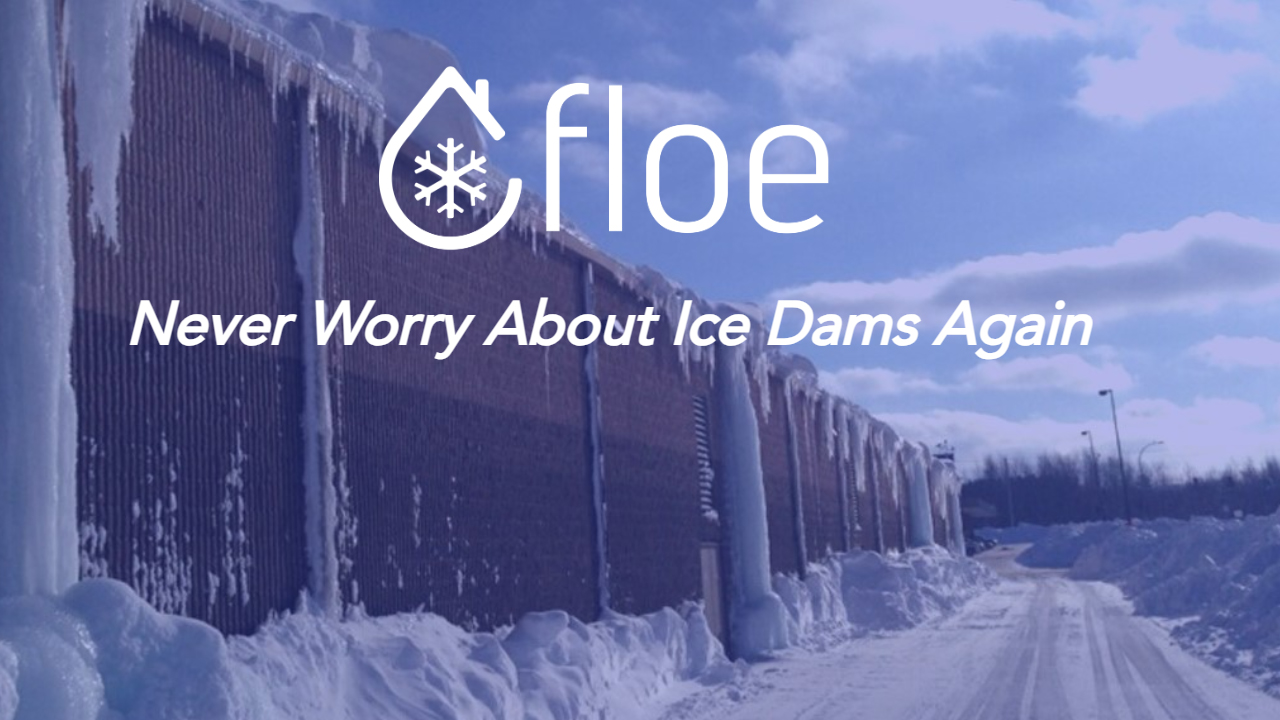Floe: Success Story

Product Development Grant-winning smart deicing system brings ice dam mitigation into the 21st century
If you don’t know what an ice dam is, consider yourself lucky. Ice dams are ridges of ice that form on roofs or in gutters when snow melts and refreezes. They cause water leakage inside buildings, resulting in mold, mildew, and structural damage. Ice dams cost Americans $9 billion in property damage every winter. And, with climate change causing polar vortex cold waves like the one that struck the American South in 2021, ice dams are likely to be a bigger problem in the future. 62M+ buildings are at risk for ice dams in the US alone.
The conventional methods for getting rid of ice dams are less than ideal. Building owners can install energy-hogging heating wires on the roof or put workers at risk by sending them up a ladder to melt or chip the ice away. Both options are expensive and inefficient. What if there were a better way to deal with ice dams? Thanks to Floe, there is.
How a college project became a national pilot

The idea for Floe came from a mechanical engineering class CEO and cofounder David Dellal took while he was an undergraduate at MIT. He and his classmates commiserated about dealing with ice dams, which inspired his team to use their capstone engineering class to design an alternate solution.
“Floe spun out of that class, and I’ve been running with it ever since,” Dellal said.
A floe is a piece of ice floating on water. Since Floe’s product creates drainage channels under ice dams, the name just made sense. To create those channels, Floe’s product first needs to know when a roof has ice dams. The product uses sensors, proprietary algorithms, and online data to monitor for ice. At just the right time, it drips de-icing fluid onto the roof, clearing a path for meltwater. The product is barely noticeable from the ground, and the deicing fluid is water-based and nontoxic.
Better yet, Floe costs 40% less and emits 99% less carbon than other ice dam solutions.
“We’re focused on mitigating the impact of climate change by reducing emissions and adapting to extreme seasonal weather,” Dellal said. “Texas had more snow in the past 3 years than anytime in recent memory. Nobody’s prepared for that. That’s why an easy, cost-effective retrofit like Floe is so important.”
Preparing for a full launch with the FORGE Product Development Grant
Floe started at MIT in Cambridge, MA in 2017, and got involved with FORGE early on. The company won an Audience Choice Award at FORGE’s 2020 Manufacturing and Innovation Showcase.
Dellal said, “We love FORGE! FORGE has a plethora of resources for advisors, capital, industry connections, and a sense of timeline. I don’t know if we would be here without FORGE. We’ve taken advantage of multiple resources from FORGE to get our product to the next level.”
Floe has spent the last few years leveling up. Testing its prototype in real-life conditions meant waiting for winter, so Floe also used cold chambers at MIT and U.S. Army facilities. In 2020-2021, Floe did a country-wide trial, which showed that its product successfully mitigates ice dams on buildings from single-family homes to 100,000-square-foot warehouses.
Dellal and Floe’s CTO Hector Castillo moved Floe to Connecticut when they became engineering PhD students at Yale. Dellal said they were worried about missing out by leaving FORGE behind in Massachusetts, so they were excited to hear FORGE was expanding to CT.
“We’ve reconnected with them now that they’re in the state,” Dellal said. “They mentioned the cleantech grant to us and we thought it’d be a perfect fit.”
Floe won a FORGE Cleantech Product Development Grant grant in 2023. The company is now preparing its product for production and is in the process of finding a contract manufacturer. The grant will help Floe finalize key pre-production steps. Plus, Floe is turning to FORGE for a connection to a manufacturer.
Looking Forward: updating the deicing industry
Dellal said, “Connecting to CT manufacturers is exciting. Since they’re so close, it’s easy to check out the manufacturing center, and we can drive over if there’s a problem during production.”
“Modern technology has penetrated so many aspects of our lives, but there are still so many industries that are antiquated and need a revamp. Deicing is one of those industries,” Dellal said. Floe is focused on improving ice dam mitigation for buildings right now, but Dellal sees the company expanding to mitigating ice and snow on roads, runways, and even railroads. He sees the potential to use a data-driven approach to reduce pollution from runoff, and unnecessarily labor-intensive deicing methods.
“We have the technology to bring deicing into the 21st century,” he said.
By the Numbers
- The deicing market is worth more than $1 trillion dollars globally – everything from runways to wind turbines needs to be deiced
- Floe costs customers 40% less than conventional ice dam solutions
- Floe uses 99% less energy than conventional ice dam solutions
- 62M+ buildings are at risk for ice dams in the US alone
- The EPA estimates that 20B lbs of US asphalt roofing shingles annually end up in landfills
